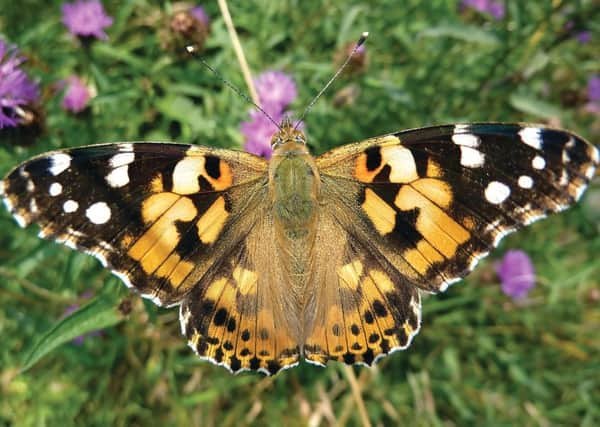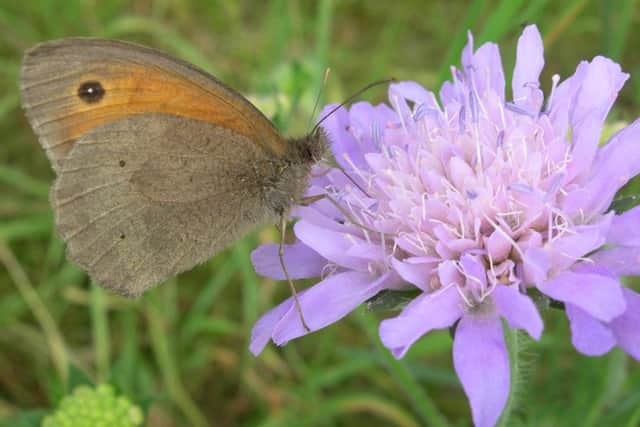Wildlife: Take a closer look at butterflies


As Harrogate’s meadows, gardens and grassy banks burst into spectacular colour, thousands of these fluttery forms are emerging from their pupal shells and starting their quest to find the perfect mate.
Each of the UK’s 59 butterfly species hass a set of distinctive wing patterns and colours and with practice and a little know-how anyone can become a butterfly buff.
Advertisement
Hide AdAdvertisement
Hide AdSome 24of these were spotted on the Yorkshire Wildlife Trust’s reserves in Harrogate last year, so where better to get started?


The first trick to successful identification is scoring the perfect butterfly hat-trick - food, sun and shelter.
Bishop Monkton Railway Cutting and Staveley Nature Reserve are fantastic places to begin your search as they are carpeted in swathes of nectar-filled flowers in June, the ideal picnic for a ravenous butterfly.
These creatures are the ultimate sun seekers and fussy flyers, so choose patches that are basked in glorious sunlight and protected from the wind. They are flighty and often easily disturbed, so approach slowly and try to take a photo if they stay still for long enough.
Advertisement
Hide AdAdvertisement
Hide AdThe second trick is to know which species are likely to be out and about from month to month; this will limit the number of species you need to look out for on each identification trip and it can be helpful to focus on learning just a few common species to begin with.


June is a particularly interesting month in the butterfly calendar, as many early spring species start to disappear and a second wave of newcomers arrive on the scene.
Start with the meadow brown, a familiar sight at all of our reserves throughout the summer months and one that is likely to be seen out and about even on the more typical dreary days of the season.
As the name suggests, this species is largely brown, but its forewings are orange-tinted with a black eyespot towards the tip. Its main identification rival is the gatekeeper, another large brown butterfly that emerges in July, but the former has one dot at the centre of its eyespot rather than two.
Advertisement
Hide AdAdvertisement
Hide AdButterflies aren’t as fluttery and fragile as they may seem. In fact, some of our most-loved butterflies are incredibly powerful flyers and long-distance migrants.
The painted lady is one such feat of aeronautical engineering. Its caterpillars enjoy the balmier winters of North Africa, before the newly emerged adults travel throughout Europe in the spring, with the numbers that reach our shores fluctuating from year to year depending on the weather conditions. They can be seen holidaying on clumps of thistles at Ripon Loop, the perfect re-fuelling station for a weary traveller.
For the ‘Where’s Wall-y’ challenge, look out for the wall, an orange-brown butterfly best-spotted basking in sunny spots on bare ground and, you’ve guessed it, walls. This insect had its worst year on record in 2015, and we only had a couple of sightings across all of our Harrogate reserves last summer.
Fascinatingly, research suggests that milder temperatures may be tempting the late summer adults into producing their own offspring rather than settling down to hibernate themselves, with these new caterpillars failing to survive the impending autumn weather.
Advertisement
Hide AdAdvertisement
Hide AdButterflies are not simply decorative ornaments of the insect world. These insects are invaluable pollinators for many of our wildflowers and by monitoring the abundance and distribution of Britain’s butterflies, we can learn a tremendous amount about the health of our grasslands and woodlands too.
The Yorkshire Wildlife Trust has a fantastic team of volunteers who help us to do just this.
From April to September they are out on a weekly basis, walking set routes called transects through our reserves in Harrogate and beyond, counting the butterflies as they go.
The trends that emerge from these recordings are useful in helping us to manage our reserves effectively, but they also feed into the national dataset compiled by Butterfly Conservation.
Advertisement
Hide AdAdvertisement
Hide AdThe north is notoriously underrepresented in the UK Butterfly Monitoring Scheme, so every data point counts. Many of the usual Harrogate butterflies were scuppered by the cool summer last year. Our 2015 results show it was a particularly bad year for the large white and small white.
From their ultra-sensitive antennae to mind-boggling life-cycles, butterflies are marvels of evolution and masters of pollination.
Next time you are out on a warm sunny day, take a closer look at the creatures as they flutter by on their meandering foraging trips and let us know what you spot at [email protected].
In fact, do something wild every day this June as part of 30 Days Wild – sign up at wildlifetrusts.org/30DaysWild to receive your inspirational pack.